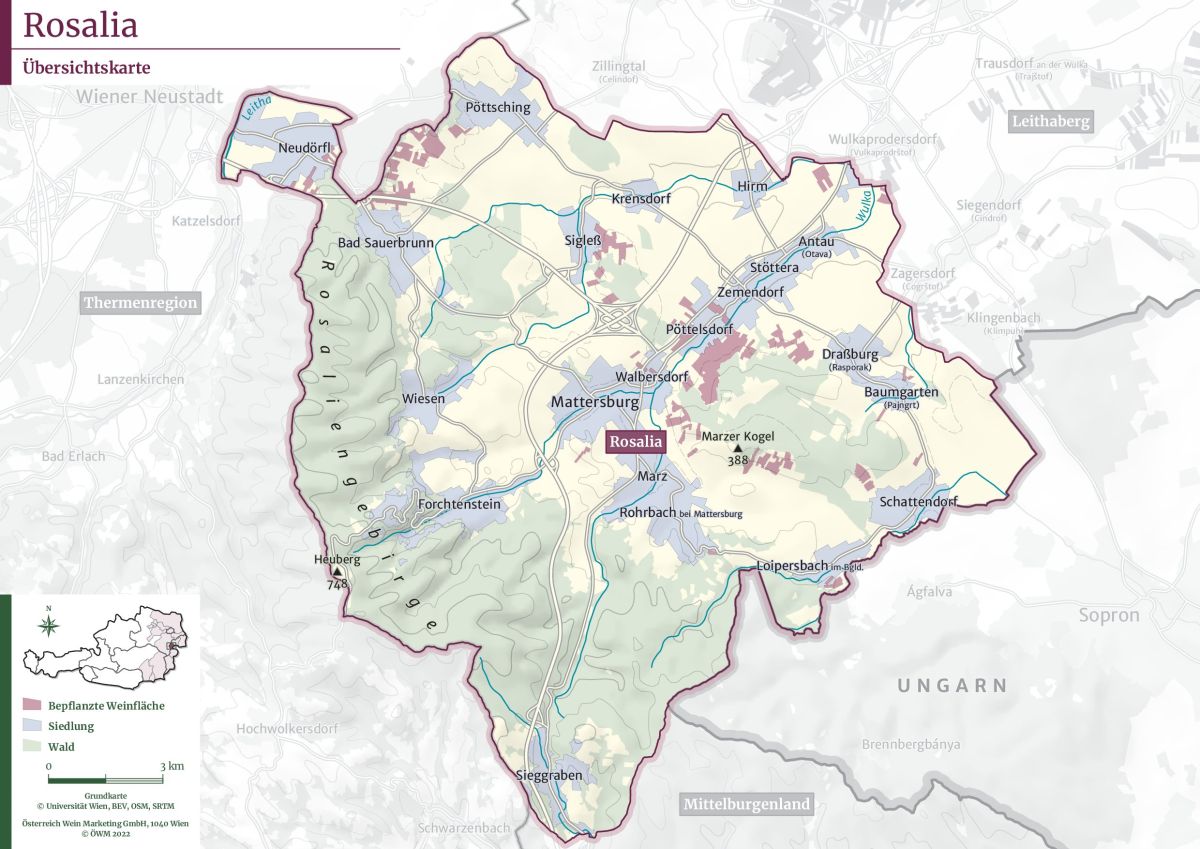Since the 2017 vintage, wine-legally defined DAC area (specific wine-growing region) in the Austrian wine-growing region of Burgenland (generic wine-growing region). See under Rosalia.
Rosalia
One of the six specific wine-growing regions in the Austrian province or generic wine-growing region of Burgenland. It was restructured in 2016 with some changes to the designations and area boundaries. The newly defined Rosalia wine-growing region replaced the former Großlage in the district of Mattersburg. It is located on the eastern slope of the Rosaliengebirge, which stretches along the border between Lower Austria and Burgenland. At 748 metres above sea level, the highest point is the Heuberg, which is also known as Rosalia. Due to the strawberry, wine, sweet chestnut and the many types of fruit cultivated here, the region has been given the nickname "Sweet Region". Large natural areas form the "Rosalia-Kogelberg" nature park. The area adjoins the Leithaberg wine-growing region to the south.
History
The area has a very old wine-growing tradition, as the Celts were already cultivating vines here 2,500 years ago. This is documented by archaeological finds.
Wine-growing communities
Rosalia comprises the municipalities of Antau, Bad Sauerbrunn, Baumgarten, Drassburg, Forchtenstein, Hirm, Loipersbach, Marz, Mattersburg, Neudörfl, Pöttelsdorf, Pöttsching, Rohrbach, Schattendorf, Sieggraben, Sigleß, Wiesen and Zemendorf-Stöttera.
Climate & Soils
A Pannonian climate prevails with mild and rainy summers and cold winters due to continental influences. Due to the proximity to the foothills of the Alps in the west, the nights cool down considerably, resulting in the climatic effect of cool climate winegrowing with wines of a special typicity. The loamy and sandy soils provide favourable conditions for viticulture, especially for red and rosé wines.

Grape variety index
In 2022, the vineyards covered 241 hectares of vines. Compared to 2017 with 297 hectares, this was a reduction of 56 hectares (18.9%). The share of white wine varieties is 23%, the share of red wine varieties 77%. The red wine variety Blaufränkisch, followed by Zweigelt and Grüner Veltliner, dominates with just under half of the total area.
Grape variety
|
in Austria
|
colour |
HA
|
%
|
HA
|
%
|
| Blaufränkisch | - | red | 112 | 46 | 155 | 52,0 |
| Zweigelt | Blauer Zweigelt, Rotburger | red | 45 | 18,5 | 46 | 15,5 |
| Grüner Veltliner | Weißgipfler | white | 19 | 8 | 21,5 | 7,3 |
| Merlot | - | red | 9,4 | 3,9 | 7,0 | 2,4 |
| Chardonnay | - | white | 6,6 | 2,7 | 3,7 | 1,2 |
| Muscat | Yellow M., Red M. /... |
Voices of our members

As honorary chairman of the Domäne Wachau, it is the easiest and quickest way for me to access the wein.plus encyclopaedia when I have questions. The certainty of receiving well-founded and up-to-date information here makes it an indispensable guide.
Hans-Georg Schwarz
Ehrenobmann der Domäne Wachau (Wachau)